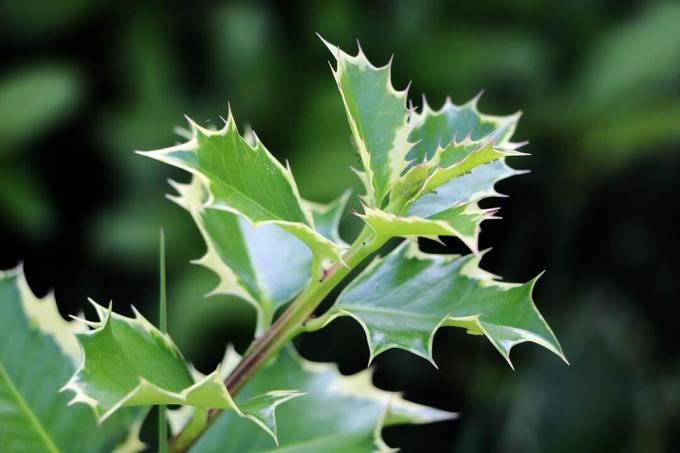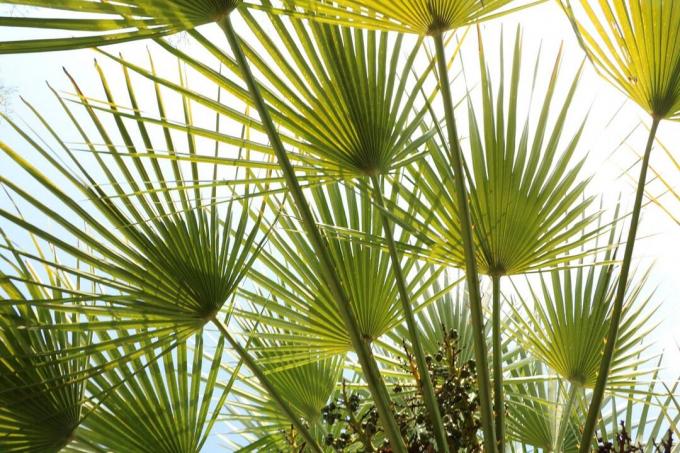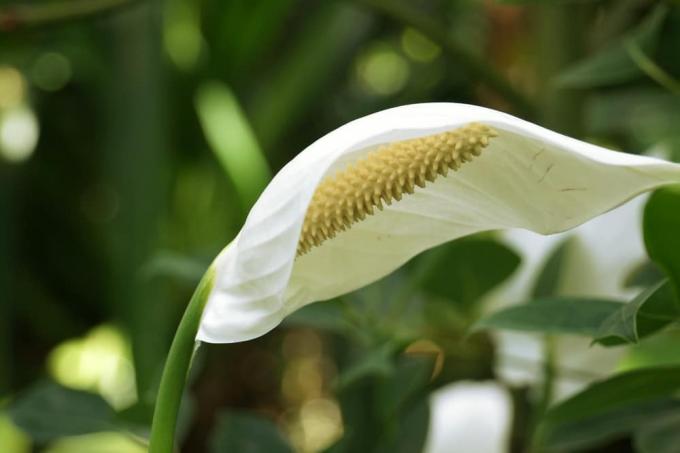

Table of contents
- location and soil
- Plant
- use
- Important Species
- propagation
- Pour
- Fertilize
- Cut
- hibernate
- diseases and pests
Also known as the European holly, Ilex aquifolium is the only plant of the holly genus native to our latitudes. Due to its easy care and its rich red berries, the holly enjoys great popularity in landscape gardening.
location and soil
Like almost all holly, the native European holly also has a preference for shady or semi-shady places. However, the rather undemanding wood is also satisfied with a sunny location, insofar as the humidity is high and the soil is correspondingly moist. This also applies vice versa. The drier the location, the shadier it can be. As true forest trees, site conditions should be appropriate. An optimal soil has a slightly acidic environment and consists largely of nutrient-rich humus. A fresh and well-drained soil is a basic requirement for good growth. Dense loamy soils with a high lime content, on the other hand, you will not get.
Plant
Like the deciduous Ilex Verticillata, spring is suitable for planting or sowing. In any case, it is important to wait until the frosts subside. This gives the hedge enough time to grow into the ground over a season and form a base against the harsh winter. Especially loamy soils should be thinned before planting by spreading leaf humus and sand over a large area. A dense or cohesive soil is unwelcome. When planting as a hedge, it is important to pay attention to the required distance between the plants. Depending on the specimen, there are between two and six plants per meter. This is how an Ilex plant can be successfully planted:
- Planting takes place in the spring after the last frost
- Water the root ball extensively in the bucket
- Dig a plant hole (almost one and a half times as wide as the root ball)
- Mix in slow-release fertilizer or excavated compost
- Mix with 1/3 potting soil and 1/3 sand for calcareous or loamy soil
- Tear down compacted roots with a spade to encourage rooting
- Insertion of the plant up to the root neck
- Filling the plant hole
- face earth
- Water generously

use
The plant is ideal as a hedge or topiary. Particularly robust varieties from the Ilex family also thrive in exposed places. Even in frosty temperatures and the blazing winter sun, leaf damage or frost dryness are kept in check. The plants are particularly suitable for Asian-style gardens in combination with other evergreen plants. More compact varieties are also suitable as solitary shrubs in a container culture. Above all, the native variety, the Ilex aquifolium, serves as a valuable bird nesting tree. During the summer months it provides bees and bumblebees with nectar and also acts as an insect hotel, while birds benefit from its berry splendor as a food source during the winter months.
Danger:
The berries are poisonous to humans. The fruits contain polyphenols and ursolic acid, which can lead to intestinal problems and vomiting when consumed. But not only the berries, also the green of the plants is poisonous. The parts of the plant are also poisonous for pets when consumed.
Important Species
In addition to the native Ilex aquifolium, the mountain Ilex, the Ilex verticillata, are of great horticultural importance. The Ilex crenata from Japan reaches a height of up to 150 centimeters and is therefore one of the more compact plants of the plant species. Wild species reach a growth height of up to three meters. Its thornless leaves are oval in shape. Its properties include good cut compatibility and formability. Its fruits and flowers are not very pronounced.
Native to North America, the Ilex verticillata is also known as the red winterberry and is only found in a few gardens. The deciduous shrub reaches a height of about three meters and bears bright red berries well into winter. It impresses with its beautiful autumn colors ranging from yellow to orange.
In addition to the common species cultivated in our latitudes, there are numerous other holly trees. The genus Ilex comprises roughly 600 different species, which in turn are divided into three subgenera. For example, there is the Ilex cyrtura, the Ilex denticulata, the Ilex fargesii or the Ilex ficoidea.
propagation
Larger specimens can be propagated simply by lowering them, since larger shoots in the crown area are often at ground level. In tree nurseries, the Ilex plants are only propagated by cuttings. Rooting these is a lengthy and complex process, as some ground heat is required. Propagation by cuttings is usually only possible with the help of special breeding stations. Propagation by sowing also proves to be quite complex, since the seeds are difficult to germinate and stratification is required first.

The following types of propagation are possible:
- Propagation by lowering (recommended)
- Propagation by cuttings (not recommended)
- Propagation by seed (not recommended)
The elimination of the germination inhibition, also called stratification, is a special process in which the germination capacity of various seeds is to be increased. Such inhibition of germination often occurs in perennials or woody plants in temperate latitudes. The reason is obvious: if the seeds germinate in autumn, the winter frost would kill the young seedlings. In order for the seeds to germinate, they must be exposed to very low temperatures for a long period of time.
Pour
When planting, the palm tree should be watered extensively. If the plant is rooted in the soil, the plant draws moisture directly from the soil. Normally additional watering is not necessary. Tub cultures, on the other hand, require a regular supply of water. Outdoor crops may also need to be watered in extreme droughts. It is imperative to avoid waterlogging, as permanently damp roots can lead to the death of the plant due to the onset of root rot. A low-lime irrigation water is preferable.
Fertilize
All types of holly prefer a rather acidic soil, which is why a calcareous fertilizer is not recommended. A high proportion of nitrogen in the fertilizer ensures magnificent growth. It is enough to fertilize the palm once a year. The best time for fertilization is before the growing season in spring. Is fertilized with a long-term fertilizer, such as horse manure, horn shavings or universal fertilizer.
Cut
Regular pruning is not necessary. Basically, all types of Ilex plants are very robust, cutting back in summer or spring usually does not cause any problems. A pruning is necessary for shaping or thinning. When cutting, avoid pruning too radically, as growth is very slow. The following things must be observed when cutting:
- Cut back in spring or summer
- Topiary or thinning
- No radical pruning due to slow growth
- Generally compatible with cuts
The Ilex aquifolium can be cultivated not only in the form of a shrub, but also as a standard. As a standard, it has a broadly oval or pyramid-shaped crown. As a standard it reaches a height of up to 10 meters.
Tip:
When working with holly, gloves are recommended to protect against injury from the prickly leaves.
hibernate
Overwintering holly is easy, even for home gardeners. Most species are naturally hardy and do not require any special protection in winter. Only seedlings, seedlings or young plants are not yet hardened to withstand the frosts in winter. Winter protection is suitable here, such as fleece or fir branches for insulation and protection against icy winds. Tub cultures should overwinter in a frost-free and bright place. This can be a bright hallway or an unheated conservatory.

diseases and pests
A frequent but unwelcome guest is the Ilex miner fly. The ones under their professional name Phytomyza ilicis well-known leaf mine fly usually leaves a characteristic damage in its wake on infested plants. Their larvae infest the leaf tissue and leave unsightly burrows in the foliage of the holly. The pupation of insects also takes place here. Infested plant parts should be removed and disposed of early in the spring before new generations can hatch. Last but not least, vine weevils or Otiorhynchus like to get lost in local gardens, where they feast on the fleshy leaves of holly trees. The characteristic bay damage indicates an infestation. It is easily combated using nematodes.
 garden editorial
garden editorial I write about everything that interests me in my garden.
Learn more about Exotic Plants

Dwarf palm, Chamaerops humilis: care instructions
The dwarf palm remains small enough that it can also be cared for in the room. However, it also cuts a fine figure in the garden. You can find out here how it is maintained and what needs to be considered.

Dwarf date palm, Phoenix roebelenii: Care from A-Z
The dwarf date palm (Phoenix roebelenii) is a particularly small, actually the smallest palm species of its genus. But that doesn't make them any less decorative. It is the most filigree and elegant date palm and hardly grows higher than one meter.

Growing vanilla plants: 11 tips for care
The vanilla plant is truly exotic in Central Europe and cannot be found in every garden. Vanilla planifolia forms the aromatic pods for which the plant is known. The cultivation of a vanilla plant is easily possible with the right care tips.

Kangaroo Paw: Caring for the kangaroo plant
Kangaroo paws are exotic plants native to southwestern Australia. Considering the care instructions, Kangaroo Paw can also thrive in Central European conditions. Maintenance requires a little more effort. If the plant gets enough attention, it will thank you with magnificent inflorescences.

Einblatt, Spathiphyllum: care from A to Z
Because of simple! The single sheet draws everyone's attention with its extravagant appearance. The imposing flower gives sophisticated rooms that certain something. If the houseplant is in the right place, hardly any care is required. The breeder can find out here what demands Spathiphyllum places on their location.

9 psychoactive & hallucinogenic plants in the garden
Even in this country psychoactive and hallucinogenic plants grow, many of them even in the local gardens. However, the herbal ingredients of domestic natural drugs are often characterized by a high toxic potential. Therefore, severe poisoning often occurs after consumption.
